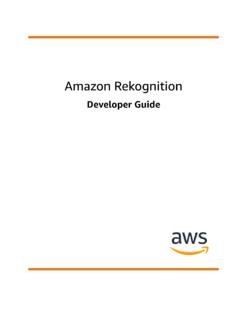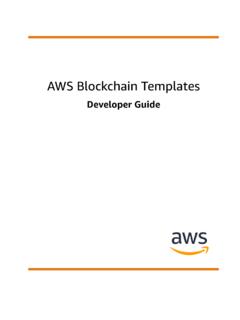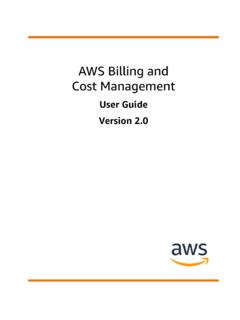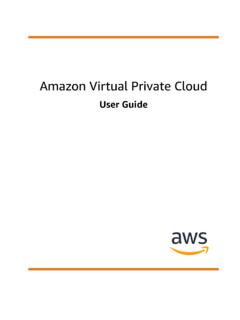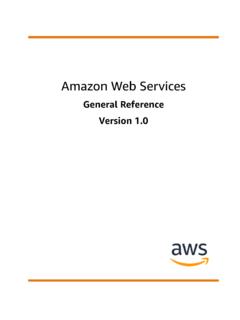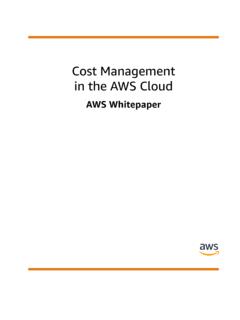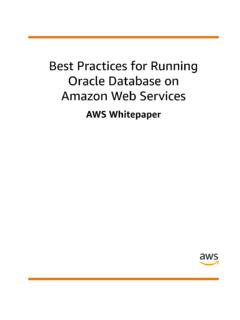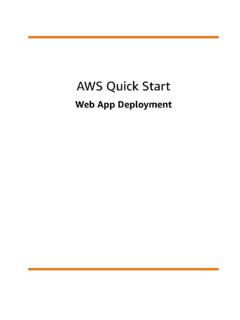Transcription of Amazon Simple Queue Service - AWS Documentation
1 Amazon Simple Queue ServiceDeveloper GuideAmazon Simple Queue Service Developer GuideAmazon Simple Queue Service : Developer GuideCopyright 2019 Amazon Web Services, Inc. and/or its affiliates. All rights 's trademarks and trade dress may not be used in connection with any product or Service that is not Amazon 's, in any mannerthat is likely to cause confusion among customers, or in any manner that disparages or discredits Amazon . All other trademarks notowned by Amazon are the property of their respective owners, who may or may not be affiliated with, connected to, or sponsored Simple Queue Service Developer GuideTable of ContentsWhat Is Amazon SQS? .. 1 What Are the Main Benefits of Amazon SQS? .. 1 How Is Amazon SQS Different from Amazon MQ or Amazon SNS? .. 1 What Type of Queue Do I Need? .. 2 How Can I Get Started with Amazon SQS?
2 3We Want to Hear from You .. 3 New and Frequently Viewed Topics .. 4 Amazon Simple Queue Service Developer Guide .. 4 Amazon Simple Queue Service API 4 Setting Up .. 6 Step 1: Create an AWS Account .. 6 Step 2: Create an IAM User .. 6 Step 3: Get Your Access Key ID and Secret Access Key .. 7 Step 4: Get Ready to Use the Example Code .. 8 Next Steps .. 8 Getting Started .. 9 Prerequisites .. 9 Step 1: Create a Queue .. 9 Step 2: Send a 9 Step 3: Receive and Delete Your Message .. 11 Step 4: Delete Your Queue .. 13 Next Steps .. 14 Tutorials .. 16 Creating Queues .. 16 Creating a Queue .. 16 Creating a Queue with SSE .. 20 Listing All 23 AWS Management Console .. 23 AWS SDK for Java .. 24 Adding Permissions to a Queue .. 24 AWS Management Console.
3 24 Adding, Updating, and Removing Tags for a Queue .. 26 AWS Management Console .. 26 AWS SDK for Java .. 27 Sending 27 Sending a 28 Sending a Message with Attributes .. 31 Sending a Message with a 35 Sending a Message from a VPC .. 37 Receiving and Deleting a Message .. 41 AWS Management Console .. 41 AWS SDK for Java .. 43 Subscribing a Queue to a Topic .. 45 AWS Management Console .. 45 Configuring a lambda Trigger .. 47 Prerequisites .. 47 AWS Management Console .. 48 Purging a Queue .. 49 AWS Management Console .. 49 Deleting a 50 AWS Management Console .. 50 AWS SDK for Java .. 51 Configuring 51 Configuring SSE for a Queue .. 52iiiAmazon Simple Queue Service Developer GuideConfiguring Long Polling for a Queue .. 55 Configuring a Dead-Letter Queue .
4 57 Configuring Visibility Timeout for a Queue .. 61 Configuring an Amazon SQS Delay Queue .. 64 How Amazon SQS Works .. 68 Basic Architecture .. 68 Distributed 68 Message Lifecycle .. 69 Standard Queues .. 70 Message Ordering .. 70At-Least-Once Delivery .. 70 Consuming Messages Using Short Polling .. 70 Working Java Example for Standard Queues .. 71 FIFO Queues .. 73 Message Ordering .. 74 Key Terms .. 74 FIFO Delivery Logic .. 75 Exactly-Once Processing .. 76 Moving from a Standard Queue to a FIFO Queue .. 76 Compatibility .. 77 Working Java Example for FIFO Queues .. 77 Queue and Message 80 Identifiers for Standard and FIFO Queues .. 80 Additional Identifiers for FIFO Queues .. 81 Message Attributes .. 81 Message Attribute Components .. 82 Message Attribute Data Types.
5 82 Calculating the MD5 Message Digest for Message Attributes .. 83 Resources Required to Process Messages .. 84 Cost Allocation Tags .. 84 Long Polling .. 85 Differences Between Long and Short Polling .. 86 Dead-Letter Queues .. 86 How Do Dead-Letter Queues Work? .. 86 What are the Benefits of Dead-Letter Queues? .. 87 How Do Different Queue Types Handle Message Failure? .. 87 When Should I Use a Dead-Letter Queue ? .. 88 Troubleshooting Dead-Letter Queues .. 88 Visibility Timeout .. 89 Inflight 90 Setting the Visibility Timeout .. 90 Changing the Visibility Timeout for a Message .. 91 Terminating the Visibility Timeout for a Message .. 91 Delay Queues .. 91 Message 92 Managing Large Messages .. 92 Working Java Example for Using Amazon S3 .. 93 Working with JMS .. 96 Prerequisites.
6 96 Getting Started with the Java Messaging Library .. 97 Using the JMS Client with Other Amazon SQS Clients .. 102 Working Java Example for Using JMS with Amazon SQS Standard Queues .. 103 Supported JMS Implementations .. 117 Best Practices .. 119 Recommendations for Standard and FIFO Queues .. 119 Working with Messages .. 119 Reducing Costs .. 121ivAmazon Simple Queue Service Developer GuideMoving from a Standard Queue to a FIFO Queue .. 122 Additional Recommendations for FIFO Queues .. 122 Using the Message Deduplication 122 Using the Message Group ID .. 123 Using the Receive Request Attempt ID .. 125 Limits Related to Queues .. 125 Limits Related to Messages .. 126 Limits Related to Policies .. 127 Monitoring, Logging, and 128 Monitoring Queues Using CloudWatch .. 128 Accessing CloudWatch Metrics for Amazon SQS.
7 128 Creating CloudWatch Alarms for Amazon SQS Metrics .. 130 Available CloudWatch Metrics for Amazon SQS .. 131 Logging API Calls Using CloudTrail .. 134 Amazon SQS Information in CloudTrail .. 134 Example Amazon SQS Log File Entries .. 135 Automating Notifications using CloudWatch Events .. 138 Security .. 139 Authentication and Access Control .. 139 Access Control .. 140 Overview of Managing Access .. 141 Using Identity-Based (IAM) Policies .. 145 Using Custom Policies with the Access Policy Language .. 153 Using Temporary Security Credentials .. 161 API Permissions Reference .. 163 Server-Side Encryption .. 165 Encryption Scope .. 166 Key Terms .. 167 Understanding the Data Key Reuse Period .. 167 Estimating AWS KMS Costs .. 168 Configuring AWS KMS Permissions .. 169 Errors.
8 171 VPC 172 Working with APIs .. 173 Making Query API Requests .. 173 Constructing an Endpoint .. 173 Making a GET Request .. 174 Making a POST Request .. 174 Authenticating Requests .. 175 Interpreting Responses .. 177 Batch Actions .. 178 Enabling Client-Side Buffering and Request Batching .. 179 Increasing Throughput using Horizontal Scaling and Action Batching .. 182 Related Resources .. 192 Release Notes .. 193 Document History .. 197 AWS Glossary .. 212vAmazon Simple Queue Service Developer GuideWhat Are the Main Benefits of Amazon SQS?What Is Amazon Simple QueueService? Amazon Simple Queue Service ( Amazon SQS) offers a secure, durable, and available hosted Queue thatlets you integrate and decouple distributed software systems and components. Amazon SQS offerscommon constructs such as dead-letter queues (p.)
9 86) and cost allocation tags (p. 84). It providesa generic web services API and it can be accessed by any programming language that the AWS SQS supports both standard (p. 70) and FIFO queues (p. 73). For more information, seeWhat Type of Queue Do I Need? (p. 2)Topics What Are the Main Benefits of Amazon SQS? (p. 1) How Is Amazon SQS Different from Amazon MQ or Amazon SNS? (p. 1) What Type of Queue Do I Need? (p. 2) How Can I Get Started with Amazon SQS? (p. 3) We Want to Hear from You (p. 3)What Are the Main Benefits of Amazon SQS? Security You control (p. 139) who can send messages to and receive messages from an AmazonSQS encryption (SSE) (p. 165) lets you transmit sensitive data by protecting the contents ofmessages in queues using keys managed in AWS Key Management Service (AWS KMS). Durability To ensure the safety of your messages, Amazon SQS stores them on multiple queues support at-least-once message delivery (p.
10 70), and FIFO queues support exactly-once message processing (p. 76). Availability Amazon SQS uses redundant infrastructure (p. 68) to provide highly-concurrentaccess to messages and high availability for producing and consuming messages. Scalability Amazon SQS can process each buffered request (p. 179) independently, scalingtransparently to handle any load increases or spikes without any provisioning instructions. Reliability Amazon SQS locks your messages during processing, so that multiple producers can sendand multiple consumers can receive messages at the same time. Customization Your queues don't have to be exactly alike for example, you can set a default delayon a Queue (p. 91). You can store the contents of messages larger than 256 KB using AmazonSimple Storage Service ( Amazon S3) (p. 92) or Amazon DynamoDB, with Amazon SQS holding apointer to the Amazon S3 object, or you can split a large message into smaller Is Amazon SQS Different from Amazon MQ orAmazon SNS?
